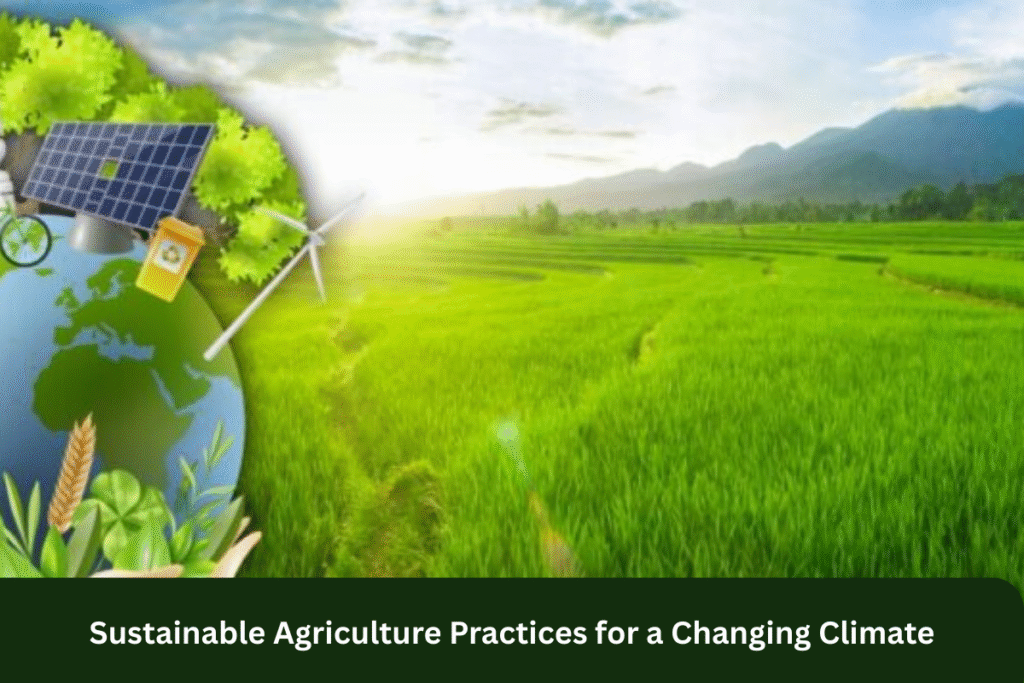
As the world faces the undeniable effects of climate change, agriculture, a key sector that feeds billions, is also significantly impacted. Changes in weather patterns, increased frequency of extreme weather events, and shifting growing seasons pose serious challenges to food security and farming. To combat these issues, sustainable agriculture practices have emerged as vital solutions to help farmers adapt to the changing climate, while reducing the environmental impact of food production. This article will explore the importance of sustainable agriculture, the practices that can be adopted, and how they help mitigate the effects of climate change.
1. What is Sustainable Agriculture?
Sustainable agriculture refers to farming practices that focus on producing food, fiber, and other plant and animal products in ways that are environmentally friendly, economically viable, and socially responsible. The goal is to meet the needs of the present generation without compromising the ability of future generations to meet their own needs.
Sustainable agriculture focuses on maintaining soil health, conserving water, reducing pollution, promoting biodiversity, and improving the resilience of farms to the impacts of climate change. This approach contrasts with conventional farming methods, which often rely on chemical fertilizers, pesticides, and monocropping that can degrade the environment and deplete natural resources.
2. Why is Sustainable Agriculture Important in the Context of Climate Change?
The agricultural sector is both a contributor to and a victim of climate change. On the one hand, farming practices such as the use of synthetic fertilizers, livestock methane emissions, and deforestation contribute to global warming. On the other hand, climate change threatens agricultural productivity through altered rainfall patterns, droughts, flooding, and temperature fluctuations.
Sustainable agriculture aims to reduce greenhouse gas emissions, increase carbon sequestration, and promote resilience to climate impacts. By adopting these practices, farmers can help mitigate climate change, while also adapting to the changing environmental conditions that threaten food security.
3. Key Sustainable Agriculture Practices for a Changing Climate
Several sustainable farming practices have been identified as effective strategies for mitigating the impacts of climate change while ensuring food production remains stable. These practices include:
a. Agroforestry
Agroforestry involves integrating trees and shrubs into agricultural landscapes. These systems offer numerous environmental benefits, including:
- Carbon Sequestration: Trees capture and store carbon, reducing atmospheric CO2 levels.
- Improved Soil Health: Tree roots help improve soil structure, prevent erosion, and increase water retention.
- Biodiversity: Agroforestry supports diverse ecosystems, creating habitats for wildlife and beneficial insects.
b. Conservation Tillage
Conservation tillage refers to practices that minimize soil disturbance. Techniques like no-till and reduced-till farming maintain soil structure, improve water retention, and reduce erosion. This practice also helps:
- Increase Soil Carbon Storage: Reducing tillage allows more organic matter to remain in the soil, enhancing carbon sequestration.
- Improve Water Efficiency: Healthy soils retain water better, reducing the need for irrigation and helping crops withstand droughts.
c. Crop Diversification and Polyculture
Monoculture farming, which involves growing a single crop over large areas, makes crops more vulnerable to pests, diseases, and climate-related stress. Crop diversification and polyculture (growing multiple crops together) can improve farm resilience by:
- Reducing Pest and Disease Pressure: A variety of crops attracts different insects and reduces the likelihood of pest infestations.
- Enhancing Soil Fertility: Diverse crops contribute to healthier soils by reducing nutrient depletion.
- Improving Yield Stability: Different crops are more likely to thrive in varying weather conditions, leading to more stable harvests.
d. Regenerative Agriculture
Regenerative agriculture is a holistic approach that focuses on restoring soil health, increasing biodiversity, and improving the overall resilience of farming systems. Practices include:
- Cover Cropping: Planting cover crops like legumes during off-seasons to enrich the soil with nutrients and reduce erosion.
- Rotational Grazing: Allowing livestock to graze in a controlled rotation to prevent overgrazing and enhance grassland productivity.
- Composting: Using organic waste materials to improve soil fertility and reduce the need for chemical fertilizers.
e. Water Conservation and Management
Water is a precious resource that is increasingly threatened by climate change. Sustainable agriculture practices that promote efficient water use include:
- Drip Irrigation: A highly efficient method of watering plants directly at the root zone, reducing water waste and increasing crop yields.
- Rainwater Harvesting: Collecting and storing rainwater for irrigation helps reduce dependence on groundwater and surface water sources.
- Water-Efficient Crops: Choosing crops that are more resilient to drought or that require less water can help conserve water resources in arid regions.
4. The Benefits of Sustainable Agriculture for Climate Change Mitigation
Sustainable agriculture practices provide a range of environmental, economic, and social benefits, including:
- Reduction of Greenhouse Gas Emissions: By using fewer synthetic inputs, such as fertilizers and pesticides, sustainable farming reduces emissions associated with agricultural production.
- Enhanced Climate Resilience: Practices such as crop diversification, soil conservation, and water management help farms better adapt to the changing climate, reducing the risk of crop failure.
- Improved Soil Health: Sustainable practices promote soil fertility and biodiversity, leading to higher yields and better food security over the long term.
- Economic Viability: By lowering input costs (e.g., chemicals and water) and improving long-term productivity, sustainable farming can be economically beneficial for farmers.
5. Challenges and Barriers to Implementing Sustainable Agriculture
Despite its numerous benefits, the widespread adoption of sustainable agriculture faces several challenges:
- Access to Resources and Knowledge: Many farmers, particularly in developing countries, lack access to training, technology, and financial resources needed to implement sustainable practices.
- Policy and Subsidy Structures: In some regions, subsidies and policies favor conventional farming methods, making it difficult for farmers to transition to more sustainable practices.
- Market Demand: While consumer demand for sustainably produced food is growing, there is still a need for greater market access for sustainably produced goods.
FAQs
1. What is sustainable agriculture?
2. How does sustainable agriculture help with climate change?
3. What are the key practices in sustainable agriculture?
4. Can sustainable agriculture increase food security?
5. What are the barriers to sustainable agriculture?
Conclusion
Sustainable agriculture is essential for addressing the challenges posed by climate change while ensuring that food production remains viable for future generations. By adopting practices that focus on environmental stewardship, soil health, and water conservation, farmers can reduce emissions, enhance resilience to climate impacts, and improve food security. While there are challenges to widespread adoption, the benefits of sustainable agriculture for both the environment and the economy make it a crucial strategy for mitigating the effects of climate change and creating a more sustainable future.
ChatGPT can make mistakes. Check important info. See Cookie Preferences.
